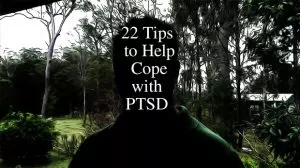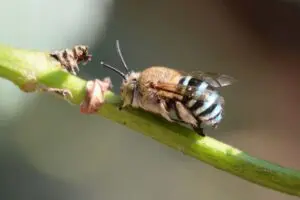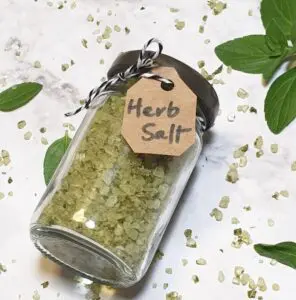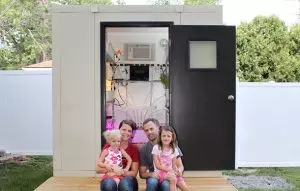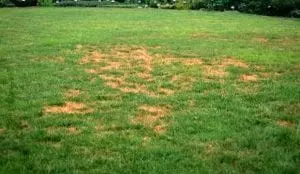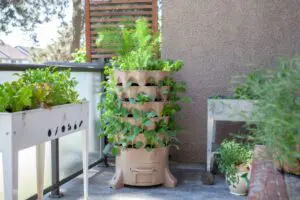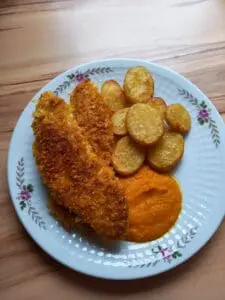Choosing the best type of raised garden bed to make or buy for a vegetable garden can become quite confusing these days with so many different options available. This article gives the pros and cons of the most popular types of raised garden beds to hopefully give people a better idea as to what might best suit them.
The different raised garden beds outlined in this article are: Colorbond; hardwood sleeper; treated pine sleeper; lightweight wooden frame (flat packed); railway sleeper; poly garden bed; plastic frame bed; and garden beds made from bricks/blocks or concrete panels.
All beds prices are estimates only in AU$ and based on a 2.4w x 2.4L x 0.4H metre size (or as close to this size as possible).
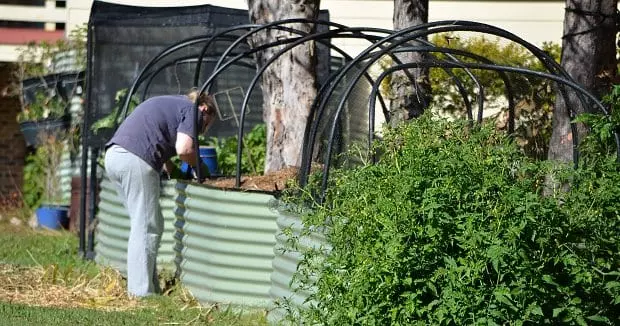
Working in a raised colorbond garden bed is so much easier on the back. The beds in the image above have been fitted with a DIY frame and anti bird/possum netting made from standard 25mm poly irrigation hose.
Colorbond garden bed ($287)
Extremely durable corrugated frame made from a mix of steel with an aluminium/zinc/magnesium alloy coating. You can also get alloy/steel galvanised frames, which look similar and also have long lasting qualities.
Pros
- Comes in many colours to suit surrounds or match home décor
- Very strong and rust resistant should last for decades
- Easy and fast to construct the bed
- Many different sizes, heights, and shapes to suit any situation
- Frames come in one chosen height and don’t need to be built up (unlike sleepers)
Cons
- Can have sharp edges
- Expensive to buy
- A bigger range can be found online (like here on eBay) but not as many different types can be found locally in stores
Hardwood sleeper ($250)
Hardwood is one of the most popular materials used to make vegetable garden beds because it’s easy to work with (just like building blocks); durable; strong, and they look good.
Pros
- Durable and should last 10 plus years (more depending on termite activity)
- Simple to construct the bed
- Look good
- Versatile – Can cut the wood to size and make the beds to suit
Cons
- Expensive to buy (usually twice the cost of pine)
- Requires at least two sleepers high for a sufficient raised bed
- Not very sustainable as hardwood grows very slowly.
Treated pine sleeper ($140)
Large treated pine sleepers are an affordable and durable material to use for landscaping projects. Without treatment, normal pinewood sleepers are an easy target for termites and rotting but treated pine will last for many years. Treated pine has been given a bad name due to the yet to be proven claims chemicals leach into the surrounding soil and then get absorbed by the growing vegetables which we in turn ingest. I've written an article here about the research I've done into treated pine and arsenic uptake in vegetables. You can also now get "vegetable safe" treated pine to use for garden planters such as Microshade as an alternative to the more expensive and less sustainable hardwood.
Whether the belief that treated pine used in garden beds leaches arsenic into the soil is true or not, if you are concerned, you can line the inside of the garden bed with builder’s plastic or some similar material so there is a barrier between the wood and soil. Personally, if you are worried about it I would not use treated pine at all because the thought that your veggies might be contaminated will always be in the back of your mind if you do.

Here's an example of raised beds in a vegetable garden using treated pine in square and long beds mixed with some colorbond and galvanised round beds (image above)

Pros
- Reasonable cost
- Durable and should last 10 plus years (more depending on termite activity)
- Simple to construct the bed
Cons
- May leach chemicals into the surrounding soil (particularly for the first several years or as the wood degrades)
- Requires at least two sleepers high for a raised bed to be sufficiently high enough
- Doesn't look as good as hardwood
Lightweight wooden frame or kit (flat packed) ($140)
These pre-made garden bed kits come in all sizes and there has been a real explosion of different types and makes onto the market. Some kits provide the joinery and accessories only and the buyer sources the wood planks locally. Amazon has an interesting range including some fully enclosed beds to protect against animals such as deer.
Pros
- Usually well priced and easy to purchase
- Easy to construct
- Look good and can suit any situation
Cons
- Quality of some materials (wood) can be dubious and therefore have a poor lifespan.
- The frame can sometimes be weak and bow under strain of heavy wet soil.
- Not always easy to find a good selection of frames locally
Railway sleeper ($200)
The traditional wooden railway sleeper is slowly being replaced by similar sized concrete sleepers and many of these replaced sleepers are in great condition. You can’t just go and take railway sleepers if you see them in a pile by the tracks as they are government property but if you know someone who has the authority to give them away then ask and go for it. More than likely, you’ll see railway sleepers for sale at council refuse tips or sold at garden supplies retailers. Prices can vary greatly from almost giveaway to $25 – $30 so do hunt around. 
Pros
- Appealing rustic look
- Can be cost effective if acquired or purchased cheaply as recycled scrap
- Simple to construct the bed
- Long lasting
Cons
- Possible chemical leach into the surrounding soil
- Can be expensive to buy if purchased through a hardware retailer
- Not always uniform in size or shape and quality can be inconsistent
Poly garden bed ($350)
Similar to poly tanks materials and were born out of the poly tank explosion in the early 2000’s when it became the most common and preferred small water tank for the home. Combining water tank with garden bed is a perfect match but positioning has to be carefully considered and the cost is prohibitive for most households.

This poly raised garden bed is also a water tank and can be used as a pond/water garden or filled with soil and used as a raised garden bed. ATM, I've filled this one with water and using it as a duck pond (image above)
Pros
- Durable but still lightweight
- Easy to assemble (no assembly in most cases)
- No sharp edges or corners
- No joins or gaps all one piece
- Some can also hold water within the frame to be used for the garden
- Look good and can be colour coded to suit décor
Cons
- Very expensive to buy (some examples are here on eBay)
- Limited sizes and small product range
- Not easy to transport
Plastic frame garden bed ($120)
Made from plastic moulds (some imitate wood) and sold flat-packed in easy to transport packages. China can make almost anything out of plastic and at a reasonable cost to the end consumer – fake garden beds are no exception! Amazon has a huge range of plastic designed raised garden beds.
Pros
- Reasonably priced
- Easy to assemble and disassemble (good for renters)
- Lightweight
Cons
- Prone to break, bow out or bulge in the sides, and deteriorate
- Not good for high sided beds
- Not easy to replace parts
- Generally, difficult to find a decent sized frame (most products are quite small).
Brick, blocks, or concrete panels ($150)
Bricks and blocks are generally good materials to use for garden beds; however, they do take some know-how and skill to do right. Lightweight concrete panels can be faster than laying bricks or blocks and once rendered look stylish.
Pros
- Long lasting
- Looks good
- Very strong
- Good insulation for plants
- Reasonably low cost
Cons
- Time consuming and skill needed to build
- Can be expensive if you are required to buy in a bulk pack more than you need or if you get someone else to lay them.
- Not easy to move
- Can crack, sink, and begin to look unsightly
My personal preferences
If money wasn’t an option, I would choose Colorbond garden beds and Hardwood sleeper garden beds (a mix of both) because they last a long time; are practical and easy to construct; come in all shapes and sizes and in the case of hardwood sleepers can be made as small or large as needed; they’re strong and don’t lose shape; and they look good. However, if the budget is a little tight treated pine (deemed safe for vegetable gardens ie Microshade) is a good alternative at around half the price of either colorbond or hardwood.
Make a comment or ask a question below or join our growing forum and be part of our online community.
Mark Valencia – Editor SSM
Look, and see the Earth through her eyes…


